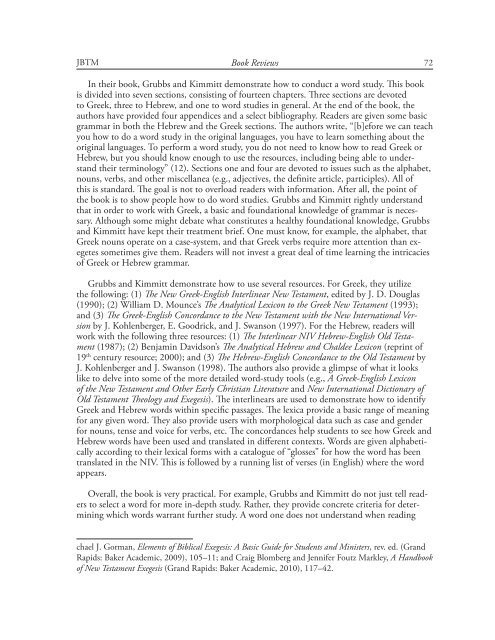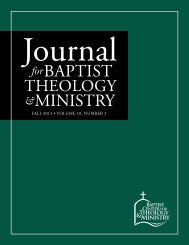Bible Translation as Missions
pTf2MG
pTf2MG
You also want an ePaper? Increase the reach of your titles
YUMPU automatically turns print PDFs into web optimized ePapers that Google loves.
JBTM Book Reviews72In their book, Grubbs and Kimmitt demonstrate how to conduct a word study. This bookis divided into seven sections, consisting of fourteen chapters. Three sections are devotedto Greek, three to Hebrew, and one to word studies in general. At the end of the book, theauthors have provided four appendices and a select bibliography. Readers are given some b<strong>as</strong>icgrammar in both the Hebrew and the Greek sections. The authors write, “[b]efore we can teachyou how to do a word study in the original languages, you have to learn something about theoriginal languages. To perform a word study, you do not need to know how to read Greek orHebrew, but you should know enough to use the resources, including being able to understandtheir terminology” (12). Sections one and four are devoted to issues such <strong>as</strong> the alphabet,nouns, verbs, and other miscellanea (e.g., adjectives, the definite article, participles). All ofthis is standard. The goal is not to overload readers with information. After all, the point ofthe book is to show people how to do word studies. Grubbs and Kimmitt rightly understandthat in order to work with Greek, a b<strong>as</strong>ic and foundational knowledge of grammar is necessary.Although some might debate what constitutes a healthy foundational knowledge, Grubbsand Kimmitt have kept their treatment brief. One must know, for example, the alphabet, thatGreek nouns operate on a c<strong>as</strong>e-system, and that Greek verbs require more attention than exegetessometimes give them. Readers will not invest a great deal of time learning the intricaciesof Greek or Hebrew grammar.Grubbs and Kimmitt demonstrate how to use several resources. For Greek, they utilizethe following: (1) The New Greek-English Interlinear New Testament, edited by J. D. Dougl<strong>as</strong>(1990); (2) William D. Mounce’s The Analytical Lexicon to the Greek New Testament (1993);and (3) The Greek-English Concordance to the New Testament with the New International Versionby J. Kohlenberger, E. Goodrick, and J. Swanson (1997). For the Hebrew, readers willwork with the following three resources: (1) The Interlinear NIV Hebrew-English Old Testament(1987); (2) Benjamin Davidson’s The Analytical Hebrew and Chaldee Lexicon (reprint of19 th century resource; 2000); and (3) The Hebrew-English Concordance to the Old Testament byJ. Kohlenberger and J. Swanson (1998). The authors also provide a glimpse of what it lookslike to delve into some of the more detailed word-study tools (e.g., A Greek-English Lexiconof the New Testament and Other Early Christian Literature and New International Dictionary ofOld Testament Theology and Exegesis). The interlinears are used to demonstrate how to identifyGreek and Hebrew words within specific p<strong>as</strong>sages. The lexica provide a b<strong>as</strong>ic range of meaningfor any given word. They also provide users with morphological data such <strong>as</strong> c<strong>as</strong>e and genderfor nouns, tense and voice for verbs, etc. The concordances help students to see how Greek andHebrew words have been used and translated in different contexts. Words are given alphabeticallyaccording to their lexical forms with a catalogue of “glosses” for how the word h<strong>as</strong> beentranslated in the NIV. This is followed by a running list of verses (in English) where the wordappears.Overall, the book is very practical. For example, Grubbs and Kimmitt do not just tell readersto select a word for more in-depth study. Rather, they provide concrete criteria for determiningwhich words warrant further study. A word one does not understand when readingchael J. Gorman, Elements of Biblical Exegesis: A B<strong>as</strong>ic Guide for Students and Ministers, rev. ed. (GrandRapids: Baker Academic, 2009), 105–11; and Craig Blomberg and Jennifer Foutz Markley, A Handbookof New Testament Exegesis (Grand Rapids: Baker Academic, 2010), 117–42.



